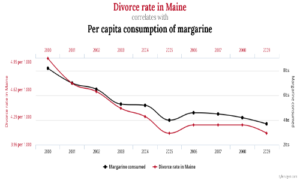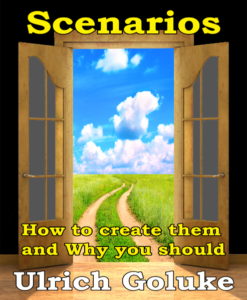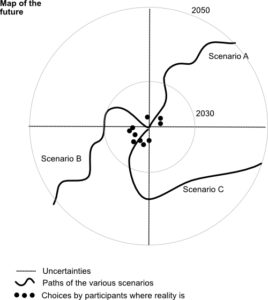To build futures you need 1) to understand the world causally, you need 2) to think the unthinkable and 3) you got to do what you got to do.
Understand the world causally
Tools (for background scroll down)
1) Start by reading the book from David Peter Stroh “Systems Thinking for Social Change: A Practical Guide to Solving Complex Problems, Avoiding Unintended Consequences, and Achieving Lasting Results“.
2) Then do the online course from Loops Consulting. It is free.
3) Then contact us to discuss how we may help you. Through our long and wide-ranging systems work, we are experienced in using system dynamics and its tools to understand how the world works. We make our skills available to you, so that intervening in your world minimizes any unintended consequences, maximizes your leverage and provides a rock solid foundation for your new futures.
4) If you want to dig deeper, check out
Places to Intervene in a System by Dana Meadows
Logic of Failure by Dietrich Dörner
Business Dynamics by John Sterman
Living Systems by James Miller
Tracing connections edited by Richmond et.al.
… read them and follow their leads.
Background
When you build new futures, you step into the way the world would have worked without your intervention. That’s the point: If you’d been content with the way things are unfolding, why make the effort? It is precisely the dissatisfaction with the way things are that drives you to build something new.
Whenever you “step into” something, it helps a lot to have some idea beforehand of what you are stepping into. If the “something” is the way the world works this becomes tricky and there are basically three ways to get “some idea”.
1) At the level of events: If you look at your life, it happens mostly on the level of events: smartphone notifications, people wanting something from you – now! – traffic jams, missed deadlines, etc. And pleasant events like team play, vacation, music – hearing and making – etc. You are not alone: the lives of most people take place on that level. One event after another and another and another. It can get confusing and make your head spin. Still, despite (or because?) of the vibrancy, distraction and confusion of this level, this is where we spend most, if not all, our time. Not surprising when each and every facebook and whatsapp notification is one such event.
2) The level of patterns: Patterns simplify the stream of events we call life and let us make predictions about tomorrow. The pattern of the night-and-day rhythm lets me go to sleep in the dark evening knowing full well that I will rise tomorrow to a bright new day.
But patterns do not, by themselves, have either the power to create order nor to predict the future. Only in combination with the absolutely critical assumption that the way the world worked in the past, is going to be the way the world will work in the future, are patterns of any use. Patterns sit on top of a deeper reality. If that reality changes, no pattern in the world can help you when you “step in” to build your new future. Still, we like patterns, just look at the success of Netflix that shows endless series that all conform to a basic pattern. We spend a lot of time with them.
Since you build new futures precisely so that the way the world works tomorrow will not be like yesterday, patterns are not good enough for our purposes. You need to go one level deeper.
3) The level of causal structure: Since we almost never pay attention to this level, let me start with an obviously crazy example: Tyler Vigen produced a book with spurious correlations. One that caught my eye correlates divorce rates in Maine with margarine consumption in the US – the correlation is near perfect:

If it weren’t so ridiculous, one could argue that to build a future with fewer divorces (in Maine) one would have to reduce margarine consumption. Why is this ridiculous? Because there is no theoretical argument, no causal structure whatsoever in the real world that connects the two. In other words, you need to find and develop theoretical arguments and a causal structure independent of what any pattern might suggest. Data mining, no matter how sophisticated the algorithm, is mere fishing for correlations. Whether they are bogus or not you need to decide with your own thinking.
It is this theoretical thinking you need to develop, learn and become proficient in before you set out to build new futures, otherwise you may well be wasting your time trying to get margarine consumption down. When you have learned to develop causal structures, your power will be substantial.
Think the unthinkable
The task ahead is substantial, check out the reasons we gave on another page. The future needs to be quite different from the past, so we should keep in mind Albert Einstein’s words “We can’t solve problems by using the same kind of thinking we used when we created them.” Easier said than done.
But there is a proven way to get us to think the unthinkable, to speak the unspeakable and to question the obvious: Transformative Scenarios. They are new stories – narratives in the jargon of today – about the reality you live in now, as well as the future into which you will move. And since the stories we tell each other about the future determine our behavior today, we are building new futures. This is especially powerful when done with others.
Learning how to create scenarios is a bit like learning how to swim. You can read about it, watch others swim, but in the end, you need to get into the water. We help you stay afloat, enjoy the experience and become a master swimmer.
We give intensive 30 hour master classes to teach you how to build scenarios. Read this document if you are a student and this one if you are a teacher for more detail. Have a look at Mastering the Future with Scenarios, a report by participants of a 30-hour master class for students of the universities of Leijden and Delft.
 We also wrote a short book that gives you concrete step-by-step guidance how to run your own scenario creation project.
We also wrote a short book that gives you concrete step-by-step guidance how to run your own scenario creation project.
The book’s landing page is here.
A sample text can be downloaded here.
To buy the book in Europe, click here.
To buy the book with world-wide free shipping, click here.
And the the link to the eBook version is here.
If you happen to be a city developer, check out this concept paper on how tranformative scenarios can augment and improve traditional stakeholder engagement processes.
If you need personal assistance, contact us by sending us an e-mail.
If you want to dig deeper, check out
Scenarios: The Art of Strategic Conversation by Kees van der Hejiden
Transformative Scenario Planning by Adam Kahane
Scenario Thinking by George Wright and George Cairns
Rethinking Strategy by Steven Tighe
Do what you got to do
You got to do what you got to do (Maine saying)
Once the scenario stories have been created, you need to change reality. You can start doing this in three ways.
1. Change the world through Strategic Interventions
Strategic interventions use the scenarios created earlier to challenge individuals and groups with the following questions: (This is the best way to help others internalize the messages and act upon them. “I hear I forget, I see I remember, I do I understand” …)
• What are the implications of each of the scenarios for you and your group / organization? What opportunities do they create? What risks do they present? What scenario has the best fit for your inherent strengths?
• What can you and your group / organization do to make the preferred scenario more likely?
• What can you and your group / organization do to make the other scenarios less likely?
Companies, most likely, will ask additional questions: How can we influence the future in light of the scenarios so that we gain most benefit from our inherent strength? What adjustments are necessary to our strategy, business model and operations to maximize your benefit?
Start with participants
Strategic interventions start with the participants of the scenario creation process, at the location of the participants. Thus, it should not be a general audience, but a homogeneous one, by participant.
For this full day effort, you present in the morning the scenarios and, if available, their quantification. Ca. 20 people from the group / organization should be present and they are encouraged to ask questions of understanding so that they internalize the narratives as best as possible. Because they need to be able to use the scenarios as sounding-boards to answer the three questions above. They should do this in small groups, one for each scenario.
• First, they work on the first question. They should work, self-facilitated, for 90 minutes on their answers and prepare a summary that each group presents in a plenary of 45 to 60 minutes.
• Then, they repeat the small group / plenary work but this time answering question two and three.
The strategic intervention should be organized by the member(s) of the organization who participated in the interviewees and / or the workshops.
Time required (by the you): 2 person-days for presenting and attending plus travel time; 1 person-day coordinating the event within the organization.
Once all participants have been visited, you should present the scenarios widely to groups, (I)NGOs, government bodies, citizens and academia. Ideally, the presentations are organized as they are for participants. If not possible, key-note presentations at annual meetings or as kick-offs for strategy and other in-house retreats should be considered. In the latter case, the speech should, in addition to presenting the scenario narrative, offer in exemplary fashion answers to the question of what the audience can do to make the sustainable chemistry scenario more likely?
If, with time, your preferred scenario does become the dominant context for the future, we recommend that you offer to trigger strategy development to the late comers – all those who have been waiting on the side lines.
If you want personal assistance, contact us by sending us an e-mail.
2. Change the world through Implementation Workshops (IW)
To actually build futures, we have to go beyond the scenario narratives the participants create. We have to implement real change. This can be kick-started by workshops that each last two days and are focused on selected professional audiences. The goal of IWs is to turn ideas into concrete projects.
You convene a dozen participants around a particular theme (for example, around concepts like macro-economics, sustainable consumption, inequality or around a specific sector such as gaming or healthcare provision …) where IW participants develop the desirable socio-technical path for that area against the narratives of the future developed earlier.
To give an example, imagine the macro-economic theme. In a world not driven by unsustainable growth, nor unsustainable consumption, we need to rethink basic macro-economic axioms, especially the fundamental attachment of many in the field to traditional growth models. We would create a workshop of both traditional, dynamic and alternative macro economists and economic policy makers. In the morning of the first day they would hear the narratives created by the participants, presented by participants from the scenario creation phase. The implementation workshop participants would then work in small groups for a couple or three hours. The small groups would form around their personal choice of which scenario they really want to see come true. In the small groups they develop options, strategies, actions, decisions that would, if implemented, lead to their preferred narrative becoming much more likely, if not true.
In the late afternoon of the first day IW participants would in a plenary setting report to each other what they have come up with and accept comments for improvements from the others. After a joint dinner, they would, the next day, re-assemble in their small groups again and essentially create a logically linked plan of action for their portfolio of ideas that they came up with the previous day. The aim is to be able to transfer all this into a work plan with resource requirements, time requirements, funding sources, publications, communication strategies, etc. – a concrete back casting exercise, in other words. Just before lunch they would again reassemble in the plenary and report to the others their plan of action, which should include the ‘appointment’ of two or three people from the workshop responsible for getting their plan implemented.
It is likely that after the first IWs organized by you, others will pick up the baton. Your responsibility beyond the initial workshops is to organize a bi-annual conference where the IW ‘mavens’, ‘salesmen and -women’ and ‘connectors’, in Gladwell’s sense of the words (Gladwell 2000), and ‘practitioners’ who actually make the new future real, meet to make the system tip.
If you want personal assistance, contact us by sending us an e-mail.
3. Change the world through Milestone workshops (MW)
The output of the scenario creation process generates a map of possible futures. As the future unfolds, however, only one path will be taken in reality. To place the real path in the original map of the future is what milestone workshops do:

